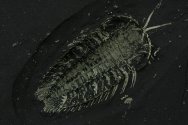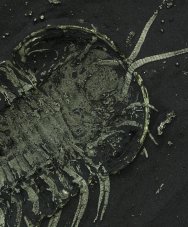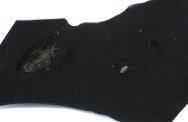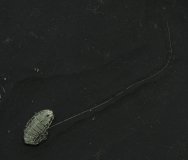|  Description:
With only about a half dozen localities known, trilobites with soft
tissue preservation are rare. A well-known site in the United States
is Beecher’s Trilobite bed where examples of Triarthrus, Cryptolithus,
and Cornuproetus are known. In 2005 a new location in Lewis County
was discovered which will take its place in this select group as
a site containing Triarthrus eatoni with preserved appendages. These
trilobites were buried rapidly, resulting in an anoxic environment
which allowed for infilling with fine-grained pyretic deposits that
preserved the details seen here. The rich gold color is a striking
contrast to the deep black matrix, making for a dramatic Description:
With only about a half dozen localities known, trilobites with soft
tissue preservation are rare. A well-known site in the United States
is Beecher’s Trilobite bed where examples of Triarthrus, Cryptolithus,
and Cornuproetus are known. In 2005 a new location in Lewis County
was discovered which will take its place in this select group as
a site containing Triarthrus eatoni with preserved appendages. These
trilobites were buried rapidly, resulting in an anoxic environment
which allowed for infilling with fine-grained pyretic deposits that
preserved the details seen here. The rich gold color is a striking
contrast to the deep black matrix, making for a dramatic 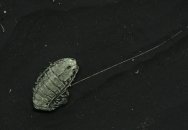 specimen
available in very limited quantities. This fine example is preserved
in ventral aspect with limbs preserved. These trilobites are prepared
using a very fine 50 nanometer powder in order to preserve the pyrite.
For the last two years at the Tucson Fossil Show the discoverer
of this site and preparator of this exceptional specimen had something
new to offer: trilobites with preserved eggs. This is the first
known instance of preserved eggs of the species, and most likely
represents an early stage in the development of the eggs which were
formed in the head and subsequently released into the environment.
This fine example is seen here in association with an unknown arthropod
with an unusually long telson extension, one which apparently was
articulated by a ball and socket joint. The distal portion of the
abdomen is tucked up against the body and the antennae folded back
along the body as well. This is a MOST UNUSUAL association of two
stunning specimens on a single plate, one which is sure to become
the cornerstone of any collection. Hopefully this arthropod and
several others will be described by science in the near future,
as they all seem to have yet to be given the attention they deserve. specimen
available in very limited quantities. This fine example is preserved
in ventral aspect with limbs preserved. These trilobites are prepared
using a very fine 50 nanometer powder in order to preserve the pyrite.
For the last two years at the Tucson Fossil Show the discoverer
of this site and preparator of this exceptional specimen had something
new to offer: trilobites with preserved eggs. This is the first
known instance of preserved eggs of the species, and most likely
represents an early stage in the development of the eggs which were
formed in the head and subsequently released into the environment.
This fine example is seen here in association with an unknown arthropod
with an unusually long telson extension, one which apparently was
articulated by a ball and socket joint. The distal portion of the
abdomen is tucked up against the body and the antennae folded back
along the body as well. This is a MOST UNUSUAL association of two
stunning specimens on a single plate, one which is sure to become
the cornerstone of any collection. Hopefully this arthropod and
several others will be described by science in the near future,
as they all seem to have yet to be given the attention they deserve.
References:
Geology, 37 (Oct), 2009, pp 907-910.
Geology, 45(3), 2017, pp 199-202.
|


